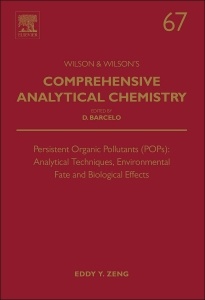Persistent Organic Pollutants (POPs): Analytical Techniques, Environmental Fate and Biological Effects Comprehensive Analytical Chemistry Series
Auteur : Zeng Eddy Y

This book focuses on those organic chemicals that are regulated by the Stockholm Convention on Persistent Organic Pollutants (POPs). as well as organic chemical with the attributes of being persistent, bioaccumulative, and toxic to ecosystem and human beings, criteria used by the Stockholm Convention for screening POP candidates. Because of the unfavourable properties of POPs, numerous research efforts have been directed toward investigating their input sources, fate, and effects, with the help of continuously improving analytical technologies. The contributors to this book provide an integrated assessment of existing data, which will benefit both the scientific and management communities in planning further research projects and/or pollution control measures.
1. Analytical methods for the measurement of legacy and emerging POPs in complex sample matricesYing Guo and Kurunthachalam Kannan2. Bioanalytical approaches to understanding toxicological implications of mixtures of persistent organic pollutants in marine wildlifeLing Jin, Caroline Gaus, and Beate I. Escher3. Fast analytical techniques based on microextractionRuifen Jiang and Gangfeng Ouyang4. Application of passive sampling techniques in measurement of HOCs in aquatic environmentsLian-Jun Bao and Eddy Y. Zeng 5. Assessment of sediment toxicity with SPME-based approachesJing You, Huizhen Li, and Michael J. Lydy6. Pharmaceuticals and personal care products (PPCPs) in the environment and their removal from wastewater through constructed wetlandsCristina Ávila and Joan García 7. Occurrence and fate of PPCPs in wastewaterTrine Eggen and Christian Vogelsang8. Atmospheric deposition of POPs: Implications for the chemical pollution of aquatic environmentsJavier Castro Jiménez, Jordi Dachs and Steven J. Eisenreich9. Electronic waste: a new source of halogenated organic contaminantsHong-Gang Ni and Eddy Y. Zeng10. Occurrence and human health risk of emerging organic contaminants in E-wasteDavid O. Carpenter11. Long-range and regional atmospheric transport of POPs and implications for global cyclingKimberly J. Hageman, Christian Bogdal, and Martin Scheringer12. Occurrence and ecological risk of halogenated flame retardants (HFRs) in coastal zonesJames C.W. Lam and Paul K.S. Lam13. Atmospheric long-range transport of persistent organic pollutants (POPs) into Polar RegionsRoland Kallenborn, Hayley Hung, and Eva Brorstrøm-Lundén 14. Bioaccumulation and biotransformation of brominated flame retardantsLiesbeth Weijs, Alin C. Dirtu, Govindan Malarvannan, and Adrian Covaci15. Bioavailability of persistent organic pollutants in soils: concept, analytical tools and application in the risk assessment, Bilqees M. Adedigba and Kirk, T. Semple16. Benzotriazoles: history, environmental distribution and potential ecological effectsMark G. Cantwell, Julia C. Sullivan, and Robert M. Burgess17. QSARs on the thyroid hormone effects of polybrominated diphenyl ether (PBDE) derivativesFei Li, Xianhai Yang, Jingwen Chen, and Felichesmi Lyakurwa18. The toxicity of persistent organic pollutants to aquatic organismsS. Michele Harmon19. Health-based risk assessment of PBDEs, Li Chen, Lucy Li, and Yunhui Zhang
Scientists engaged in research on the occurrence, fate and effects of persistent organic pollutants (POPs), teachers of advanced graduate level analytical and organic chemistry courses, environmental management and protection officers
- Comprehensive overview of recent advances in analyzing persistent organic pollutants (POPs)
- Covers input sources, fate and biological effects of POPs
- Contains essential information for environmental management
Date de parution : 03-2015
Ouvrage de 684 p.
15x22.8 cm
